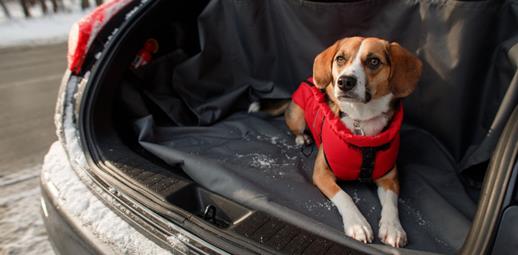
We are known as a nation of pet lovers, so it’s no surprise that pet ownership in the UK is very common.
Vet charity PDSA estimates that 27% of UK adults own a dog, and 24% own a cat[1] – totalling 21.3 million cats and dogs. And as any pet owner knows, they bring a huge amount of joy and well-being, most of the time, but extra planning is often required. Especially if you’re going away.
If you’re a new pet owner who’s travelling over the Christmas break, you may still be debating whether to take your furry pal with you or not. And how do you make sure they’re well looked after either way? Here we look at your options if you’re travelling over the festive season.
Taking your dog with you
A big advantage of having a dog is that you can easily take them with you. More and more places are becoming dog-friendly – both in terms of accommodation and getting out and about. Even some shops and banks have started to embrace our furry friends[2].
Of course, it’s a good idea to research an area with your dog in mind before you book. Are there dog-friendly pubs and eateries nearby? Will there be good places to go for a walk? Is there a nearby vet, just in case?
When it comes to travel, going by car is usually best. While dogs are allowed on trains, they’re often not ideal for longer journeys.
So, if you’re going by car, they’ll be more comfortable, and you’ll be able to pack more supplies. Make sure you’re able to keep your dog properly restrained – whether that’s with a pet seatbelt, or a dog booster seat that you can clip their harness to.
If you’re taking your dog on a road trip, you should find out what essential pet supplies you need – including how to keep them restrained.
Top Tip: It’s best not to feed dogs for at least two hours before you set off. If they regularly get car sick, it’s probably worth going to the vet to see if they can be prescribed medication for motion sickness.
If they’re a nervous traveller, read Battersea Dog & Cats Home’s guide to getting your dog used to car travel.
When on the road, be sure to take regular breaks so they can stretch their legs, drink some water and go to the toilet.
Taking your cat with you
Travelling with a cat is a bit less practical than taking a dog. Cats are territorial, so taking them out of their usual environment can be stressful. Ideally, it’s best to plan for them to stay at home, or somewhere they feel safe.
If you have no choice but to take them, there are steps you can take to help them feel more comfortable.
- Try to make their carrier as cosy as possible. Put a favourite toy and blanket with their scent inside and have a blanket or throw that you can drape over the carrier to make them feel secure. If you spray the throw with Feliway, this should help calm them down.
- If your cat’s not been inside their carrier for some time, pop them in a few times in the days leading up to your departure, so they can refamiliarise themselves.
- Pack some familiar toys and items. When you get to your destination, it may also help to rub a blanket with their scent on it around the room(s). The more they can smell themselves, the more it’ll feel like home.
Going overseas? Find out what you need for taking a dog or cat abroad at GOV.UK.
Leaving your dog behind
If you’re unable to take your dog with you, leaving them can be challenging at the best of times. And doubly so if they’re prone to separation anxiety.
While it may not always be possible, leaving them with a trusted friend or family member is often the best option. This way, your pup will be in good hands, and you can avoid the kennel costs adding up.
An alternative could be to find someone who offers home boarding. Rover is a good service for finding local house sitters and boarders, and features customer reviews to help you decide. There’s also likely to be a Facebook group for pet services in your area, where you’ll be able to source recommendations.
It’s best not to leave anything to chance though. If you’re thinking of using a boarding service, it’s definitely best to visit beforehand, so you can see where they’ll be staying. Make sure you’re happy with the environment, and that your dog’s happy with the human(s). Also, check the home is big enough for the number of dogs that’ll be visiting.
If you’re worried about how your dog may get on (or otherwise) with other dogs, try to find someone who offers a service for one dog only.
Another option is to have someone come to dog sit. This can sometimes be pricey, and not everybody’s comfortable with having someone they don’t know well in their home. However, if you can clear this mental hurdle, there can be peace of mind in knowing that not only is your furry pal being looked after, but your home is too. You should also inform your home insurer before doing this, to ensure it doesn’t affect your insurance and you are still covered. You may find that cover restrictions will apply, for example for theft or vandalism.
In addition to using Rover, it’s worth considering signing up to a site such as housesittersuk or animalaunts. These companies can link you up with someone to look after your home, and any pets, and can prove great value for money if you’re going away for a few weeks, or if you plan to go away a few times in a year. Again, make sure you check you are still covered with your home insurance provider if you decide to use this option.
This can also work out well for animal lovers visiting your area, who get accommodation in return for looking after your pet. Just be sure to communicate your dog’s needs clearly, including the amount of time they can be left alone for.
Finally, you might consider leaving your dog in boarding kennels. This is often comparatively inexpensive. However, it’s likely to suit some dogs more than others. If your dog is outgoing and likes other dogs – but doesn’t mind being left alone for spells of time – then kennels may well work for you.
However, you should always go to see them for yourself. And think twice about leaving your dog in kennels if they’re nervous, or unsure of other dogs. While all boarding kennel websites tend to promise a stress-free and enjoyable environment, you’ll be able to be the judge of where your dog will be happy.
Leaving your cat behind
Leaving a cat at home is probably the easiest and least disruptive of all options. But you’re still likely to need someone to call round and check on them, even if you have an automatic feeder and they do their business outdoors.
And you’ll certainly need someone to call round daily if they’re a house cat. Partly to make sure that they’re fed and their litter’s cleaned, but also because – despite how aloof they often seem – cats like human company too. Usually.
Again, if there aren’t any friends or family members who can call round, Rover and Facebook groups are good options for finding cat lovers who can make home visits.
Finally, you could look into taking them to a boarding cattery in your area. This usually means their dry and wet food will be looked after, and bedding and heating provided.
But, as mentioned, it’s worth remembering that cats are territorial. Even if the cattery is of an exceptional standard, there’s still a good chance your cat will find the experience unsettling. On the plus side, the staff are very likely to be cat-loving professionals, who will look after your pet to the best of their ability.
If you do arrange any pet care that involves people coming to your house while you’re away, be sure to check with your home insurance provider that you are still covered appropriately.
For more pointers on how to keep your pets safe and happy, go to Solved.
[1] https://www.pdsa.org.uk/what-we-do/pdsa-animal-wellbeing-report/paw-report-2022
[2] https://www.thesun.co.uk/money/15259641/shops-banks-customers-dogs-in-boost-spending/


